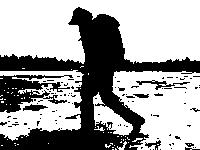Steamers, or soft-shelled clams, are a popular food in the Northeast and so are an important economic resource. But their numbers are dwindling, possibly due to predation by green crabs. Read how Emma Greenberg ’18 is contributing to the knowledge about these marine animals, as told by Emily Weyrauch ’17 in the latest installment of her series on Kent Island life.

Emma Greenberg ’18 does research in Kent Island’s intertidal zone
Many Bowdoin students find themselves working 9 to 5 with summer internships and jobs. On Kent Island, however, Emma Greenberg ’18 follows a different cycle: the ebb and flow of the tide.
Greenberg is working at the island’s Bowdoin Scientific Station this summer on an experiment in the intertidal zone, the area that is under water during high tide and exposed during low tide. She is studying the population of soft-shelled clams and their predation by the invasive green crab species in the area.
“Every day my schedule is different. I have to plan accordingly on how to get out to the intertidal zone at the right time,” said Greenberg, who sometimes has to wake up before 5 a.m. and then later miss out on the daily 6 p.m. communal dinners. “Not only so that I can spend more time in the [study site] plots, but so that I can be safe with the water and the currents here,” she added.
 Greenberg is looking at the survival rate of soft-shelled clams in relation to their proximity to rocky outcroppings — where the green crabs retreat during low tide — and their elevation in the intertidal zone. Since crabs only come out to feed when they are immersed by the tide, clams in the lower intertidal zone should be more vulnerable to predation.
Greenberg is looking at the survival rate of soft-shelled clams in relation to their proximity to rocky outcroppings — where the green crabs retreat during low tide — and their elevation in the intertidal zone. Since crabs only come out to feed when they are immersed by the tide, clams in the lower intertidal zone should be more vulnerable to predation.
Soft-shelled clams — also known as steamers — in both Maine and in New Brunswick, Canada, are an important economic resource. Because their populations have been on the decline in the last several years, people are seeking to pinpoint a cause.
“Right now in the popular press, green crabs are the boogeyman,” said Bowdoin Scientific Station Director Damon Gannon. “They are often blamed for a large part of that decline, but there isn’t a whole lot of actual real hard data on how much of the decline is caused by green crabs as opposed to other things.”
 Greenberg lists other possible factors — ocean acidification due to climate change, harvesting by humans, diseases and parasites, and other predators — that could be impacting the clam populations.
Greenberg lists other possible factors — ocean acidification due to climate change, harvesting by humans, diseases and parasites, and other predators — that could be impacting the clam populations.
Gannon, who is the first Bowdoin Scientific Station director who is also a marine ecologist, usually has at least one student (and up to four) working in the intertidal zone. “This is a fantastic place to do intertidal ecology since we have such enormous tides,” he said, noting that a spring tide on Kent Island, which is in the Bay of Fundy, is about 24 feet.
Although many visitors to Kent Island cite its white and red spruce forests and large open fields as some of its most beautiful areas, Greenberg acknowledges the charm of her study area, where the tides move in an out twice a day, creating a unique ecosystem. “It’s beautiful because it’s almost like another world; it’s like stepping into the bottom of the ocean without having to go under the water,” she said.
A rising sophomore, Greenberg said she is planning on majoring biology and minoring in anthropology. She is particularly interested in different communities’ involvement in coastal ecology.
“I think human interaction and anthropological research is just as important to biological science as it is to other humanities fields,” she said. “As the world changes, with global warming and with sea level rise…places like Kent Island are going to be some of the first to be impacted. It’s an important field right now, to be involved in coastal ecology and marine ecology, and [to study] how [coastal regions] will change in our lifetime.”

